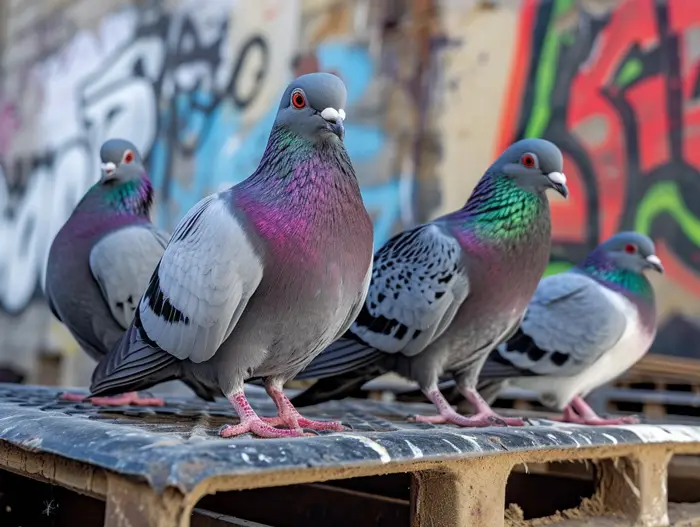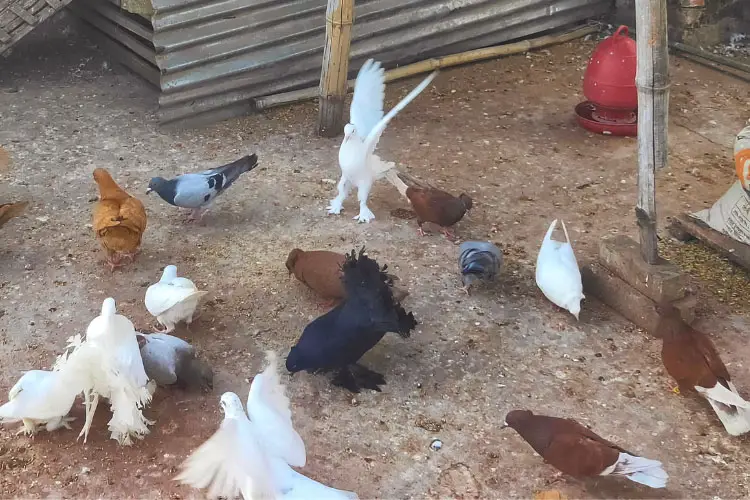How to Identify Pigeons Age: Feathers, Molts, and Color
As a seasoned pigeon enthusiast, I have often been asked how to determine the age of these fascinating birds. Understanding pigeon aging can be a valuable skill for bird enthusiasts and researchers alike. In this section, I will share some insights on how to identify the age of pigeons, based on my experience and research.
1. Feather Development One of the key indicators of a pigeon’s age is its feather development. Young pigeons, also known as squabs, have fluffy down feathers covering their bodies. As they mature, these down feathers are gradually replaced by proper flight feathers. By closely examining a pigeon’s feathers, I can estimate its approximate age range.
2. Eye Color The color of a pigeon’s eyes can also provide clues about its age. When pigeons are juveniles, their eyes are usually darker and lack the distinct iris coloration that adult pigeons have. As they grow older, their eyes acquire a mature color, typically ranging from orange to red. By observing the eye color, I can make an educated guess about the pigeon’s age.
3. Crop Milk Formation In the early stages of a pigeon’s life, both male and female pigeons produce a substance called crop milk to feed their young. As the squabs get older, they become less dependent on crop milk and start transitioning to a solid diet. By examining the crop area of a pigeon, I can determine whether it is still producing crop milk or not, providing a clue to its age.
4. Flight Stamina Another factor to consider when assessing a pigeon’s age is its flight stamina. Young pigeons are typically less experienced and have shorter flight times compared to adult pigeons. By observing their flying abilities and endurance, I can make an estimation of their age.
5. Leg and Beak Color The coloration of a pigeon’s legs and beak can vary depending on its age. Young pigeons often have softer, lighter-colored legs and beaks. With time, these features become more rigid and darken in color. By paying attention to these characteristics, I can make an educated guess about the pigeon’s age.
Physical Characteristics Used for Age Identification

As a bird enthusiast or researcher, it is important to closely observe and analyze the physical characteristics of pigeons to determine their age. Here are some key indicators that can help in age identification:
1. Feather Development: Pigeons go through different stages of feather growth as they age. Younger pigeons have softer feathers that gradually become stronger and more fully developed as they mature. By examining the texture, color, and condition of the feathers, we can get important clues about their age.
2. Eye Color: Pigeons have different eye colors at different stages of life. While young pigeons have bluish-gray or gray eyes, adult pigeons have a more distinct and darker eye color. This change in eye color can give us a good estimate of their age.
3. Crop Milk Formation: Adult pigeons produce a nutritious substance called “crop milk” to feed their young. This production of crop milk is an indicator of maturity and is not present in younger pigeons. By observing the presence or absence of crop milk, we can determine if a pigeon is a juvenile or an adult.
4. Flight Stamina: Younger pigeons may have less endurance and stamina when it comes to flying long distances. Their flight feathers may not be fully developed, resulting in shorter flights compared to mature pigeons. By assessing their flight abilities, we can approximate their age range.
5. Leg and Beak Color: Similar to eye color, the color of a pigeon’s legs and beak changes as it ages. Young pigeons have paler or lighter-colored legs and beaks, while adults have darker colors. This difference in coloration is an important clue when determining the age of a pigeon.
By carefully observing and analyzing these physical characteristics, we can make educated guesses about the age range of a pigeon. However, it is important to note that these indicators are not definitive and can vary depending on individual pigeons. Additionally, using multiple characteristics together can provide a more accurate estimation. When in doubt, consulting with experienced bird experts or researchers can help in confirming the age of pigeons.
Now that we have explored the physical characteristics used in age identification, let’s move on to the next section where we will discuss behavioral cues that can further assist us in determining the age of pigeons.
Plumage Color and Patterns
One of the key factors in determining the age of pigeons is their plumage color and patterns. As pigeons age, their feathers go through distinct changes, making it easier to estimate their age range. Here are some important things to look for:
- Juvenile plumage: When pigeons are born, they have a distinct plumage that is different from adult pigeons. Juvenile pigeons typically have a more uniform and dull coloration, with less defined patterns.
- Sub-adult plumage: As pigeons mature, they start developing their sub-adult plumage. During this stage, their feathers become more defined, and they start to display distinct color patterns. However, their plumage may still differ from adult pigeons in terms of intensity and brightness.
- Adult plumage: Adult pigeons have fully developed plumage, which is vibrant and consistent. Their feathers have sharp patterns and are generally more colorful compared to juveniles and sub-adults. The color variations in adult pigeons can range from shades of gray, brown, white, and even iridescent hues.
By closely observing the plumage color and patterns, you can get a rough idea of the pigeon’s approximate age. However, it is important to note that some pigeons may have genetic variations that affect their plumage, so it’s best to consider other indicators as well.

Feather Development and Eye Color
Feather development and eye color are other key indicators that can help determine the age of pigeons. The growth and condition of feathers can give insights into the pigeon’s age, as feathers undergo changes as pigeons get older.
Additionally, eye color can also provide valuable information. Juvenile pigeons typically have darker eyes, which lighten as they mature into adults. Therefore, the color of a pigeon’s eyes can be a good clue in estimating their age.
It’s important to note that these indicators should be used in conjunction with other methods to get a more accurate estimate of a pigeon’s age. In the next section, we’ll explore crop milk formation and how it can provide further insights into a pigeon’s age range.
Feathers and Molt Patterns
Feathers can provide valuable clues about the age of pigeons. As birds grow older, their feathers undergo specific changes, which can help us determine their approximate age range. By closely observing their plumage and molt patterns, we can gain insights into their development over time.

Feathers:
- Down feathers: These are the first feathers that pigeons develop as nestlings. They are soft and fluffy, helping to keep the chicks warm and protected. Nestling pigeons typically have down feathers until they are around one to two weeks old.
- Juvenile feathers: After the down feathers, young pigeons start growing juvenile feathers. These feathers are generally less fluffy and more structured compared to down feathers. They appear fairly uniform in color and lack distinct patterns. Juvenile feathers start to emerge when the pigeon is about 2-3 weeks old.
- Adult feathers: Adult feathers replace the juvenile feathers as the pigeon continues to grow. These feathers are fully developed and have specific color and pattern characteristics that are unique to each individual. The transition from juvenile to adult feathers usually occurs between 6 and 12 weeks of age.
Molt Patterns:
- Pre-basic molt: Around 4-5 months old, pigeons go through their first complete molt, called the pre-basic molt. During this molt, the pigeons shed their old feathers and grow new ones.
- Basic molt: Following the pre-basic molt, pigeons experience annual molts called the basic molts. Basic molts occur in adults and are marked by the replacement of worn-out feathers. Adult pigeons molt their flight feathers, tail feathers, and other body feathers. The timing of basic molts can vary among individuals but generally occurs once a year.
It’s important to remember that there can be some individual variation in feather development and molt patterns among pigeons. Environmental factors, nutrition, and genetics can also influence the timing and appearance of feathers. Consulting with experienced bird experts or researchers can help confirm age estimates based on feathers and molt patterns.
In the next section, we will explore another indicator of a pigeon’s age: eye color. Stay tuned to learn how eye color can further assist us in determining the age range of these fascinating birds.
Beak and Eye Color
When it comes to identifying the age of a pigeon, the beak and eye color are important indicators. As pigeons grow older, their beaks and eyes undergo changes that can help us determine their age range.

1. Beak Color
The color of a pigeon’s beak can give us clues about its age. Generally, younger pigeons have beaks that are softer and lighter in color, while older pigeons have harder and darker beaks. This is due to the fact that a pigeon’s beak hardens and darkens with age as they reach adulthood.
2. Eye Color
Similar to beak color, the color of a pigeon’s eyes can also provide valuable information about its age. Younger pigeons typically have lighter-colored eyes, often ranging from lighter blues to grays. As they mature, their eye color deepens and becomes richer, often turning into darker shades of blue or even red.
By observing the beak and eye color of a pigeon, experts can make educated estimates about its age. However, it’s important to note that there can be variations in these color changes, and consulting with avian experts can help confirm age estimates.
Conclusion
Determining the age of pigeons can be a challenging task, but by closely examining their feathers, molt patterns, beak, and eye color, we can make educated estimates. Feathers play a crucial role in age identification, as pigeons develop different types of feathers at different stages of their life. Additionally, understanding the timing and characteristics of molts can provide valuable insights into a pigeon’s age.
In this article, we also explored the significance of beak and eye color in determining a pigeon’s age. Younger pigeons tend to have softer and lighter-colored beaks and eyes, while older pigeons have harder and darker beaks and deeper, richer eye colors. However, it’s important to note that there can be variations in these color changes, so consulting with avian experts is essential for accurate age estimation.
Remember, individual variation in feather development, molt patterns, and color changes can occur, making it crucial to seek professional advice when identifying a pigeon’s age. By combining our knowledge with expert guidance, we can confidently determine the age of these fascinating birds.






